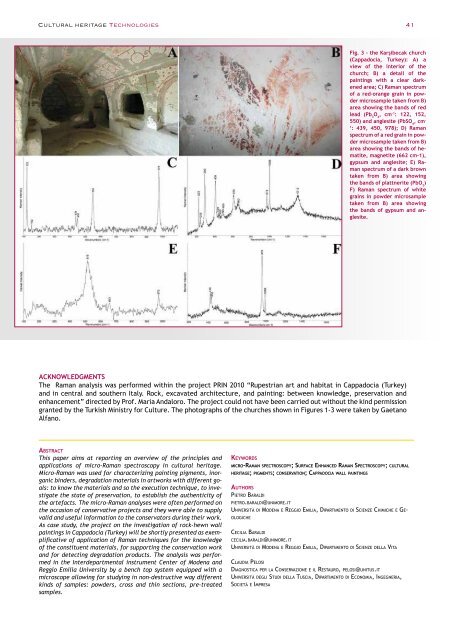Archeomatica International 2017
Special supplement to Archeomatica 3 2017
Special supplement to Archeomatica 3 2017
Create successful ePaper yourself
Turn your PDF publications into a flip-book with our unique Google optimized e-Paper software.
Cultural heritage Technologies 41<br />
Fig. 3 - the Karşibecak church<br />
(Cappadocia, Turkey): A) a<br />
view of the interior of the<br />
church; B) a detail of the<br />
paintings with a clear darkened<br />
area; C) Raman spectrum<br />
of a red-orange grain in powder<br />
microsample taken from B)<br />
area showing the bands of red<br />
lead (Pb 3<br />
O 4<br />
, cm -1 : 122, 152,<br />
550) and anglesite (PbSO 4<br />
, cm -<br />
1<br />
: 439, 450, 978); D) Raman<br />
spectrum of a red grain in powder<br />
microsample taken from B)<br />
area showing the bands of hematite,<br />
magnetite (662 cm-1),<br />
gypsum and anglesite; E) Raman<br />
spectrum of a dark brown<br />
taken from B) area showing<br />
the bands of plattnerite (PbO 2<br />
)<br />
F) Raman spectrum of white<br />
grains in powder microsample<br />
taken from B) area showing<br />
the bands of gypsum and anglesite.<br />
ACKNOWLEDGMENTS<br />
The Raman analysis was performed within the project PRIN 2010 “Rupestrian art and habitat in Cappadocia (Turkey)<br />
and in central and southern Italy. Rock, excavated architecture, and painting: between knowledge, preservation and<br />
enhancement” directed by Prof. Maria Andaloro. The project could not have been carried out without the kind permission<br />
granted by the Turkish Ministry for Culture. The photographs of the churches shown in Figures 1-3 were taken by Gaetano<br />
Alfano.<br />
Abstract<br />
This paper aims at reporting an overview of the principles and<br />
applications of micro-Raman spectroscopy in cultural heritage.<br />
Micro-Raman was used for characterizing painting pigments, inorganic<br />
binders, degradation materials in artworks with different goals:<br />
to know the materials and so the execution technique, to investigate<br />
the state of preservation, to establish the authenticity of<br />
the artefacts. The micro-Raman analyses were often performed on<br />
the occasion of conservative projects and they were able to supply<br />
valid and useful information to the conservators during their work.<br />
As case study, the project on the investigation of rock-hewn wall<br />
paintings in Cappadocia (Turkey) will be shortly presented as exemplificative<br />
of application of Raman techniques for the knowledge<br />
of the constituent materials, for supporting the conservation work<br />
and for detecting degradation products. The analysis was performed<br />
in the Interdepartmental instrument Center of Modena and<br />
Reggio Emilia University by a bench top system equipped with a<br />
microscope allowing for studying in non-destructive way different<br />
kinds of samples: powders, cross and thin sections, pre-treated<br />
samples.<br />
Keywords<br />
micro-Raman spectroscopy; Surface Enhanced Raman Spectroscopy; cultural<br />
heritage; pigments; conservation; Cappadocia wall paintings<br />
Authors<br />
Pietro Baraldi<br />
pietro.baraldi@unimore.it<br />
Università di Modena e Reggio Emilia, Dipartimento di Scienze Chimiche e Geologiche<br />
Cecilia Baraldi<br />
cecilia.baraldi@unimore.it<br />
Università di Modena e Reggio Emilia, Dipartimento di Scienze della Vita<br />
Claudia Pelosi<br />
Diagnostica per la Conservazione e il Restauro, pelosi@unitus.it<br />
Università degli Studi della Tuscia, Dipartimento di Economia, Ingegneria,<br />
Società e Impresa


















